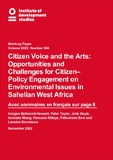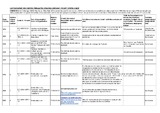Citizen Voice and the Arts: Opportunities and Challenges for Citizen–Policy Engagement on Environmental Issues in Sahelian West Africa
La Voix des Citoyens et les Arts : Opportunités et Défis pour l’Engagement Politique des Citoyens sur les Questions Environnementales En Afrique Sahélienne
| dc.contributor.author | Bellwood-Howard, Imogen | |
| dc.contributor.author | Taylor, Peter | |
| dc.contributor.author | Doyle, Julie | |
| dc.contributor.author | Niang, Aminata | |
| dc.contributor.author | Ndiaye, Haoussa | |
| dc.contributor.author | Sow, Fatoumata | |
| dc.contributor.author | Sountoura, Lansine | |
| dc.coverage.spatial | Mali | en |
| dc.coverage.spatial | Mauritania | en |
| dc.coverage.spatial | Senegal | en |
| dc.date.accessioned | 2022-12-21T11:57:35Z | |
| dc.date.available | 2022-12-21T11:57:35Z | |
| dc.date.issued | 2022-12-21 | |
| dc.identifier.citation | Bellwood-Howard, I.; Taylor, P.; Doyle, J.; Niang, A.; Ndiaye, H.; Sow, F. and Sountoura, L. (2022) Citizen Voice and the Arts: Opportunities and Challenges for Citizen–Policy Engagement on Environmental Issues in Sahelian West Africa, IDS Working Paper 584, Brighton: Institute of Development Studies, DOI: 10.19088/IDS.2022.088 | en |
| dc.identifier.isbn | 978-1-80470-078-5 | |
| dc.identifier.issn | 2040-0209 | |
| dc.identifier.uri | https://opendocs.ids.ac.uk/opendocs/handle/20.500.12413/17816 | |
| dc.description.abstract | Citizen and policy groups address environmental challenges in the Sahel, but rarely together. In Sahelian West Africa, including in Mauritania, Senegal, and Mali, artists and citizens have used protest art to make their voices heard, in contexts where this can carry risks of conflict with authorities. Artists sometimes act as engaged citizens, who can draw on their artistic talents to communicate a message. This paper explores how far art may be used as a tool for dialogue between different groups on environmental concerns in the Western Sahel. We review how art has been used in communication and dialogue globally and in the region, where activism and communication are more common than arts-led dialogue and deliberation. Field activities included an actor mapping exercise, interviews and experimental workshops, and an online platform. We found that hierarchies and sectoral silos contribute to a lack of dialogue. Communication of protest messages, although easier, runs the risk of confrontation with authorities. There is a degree of compromise between amplifying an undiluted ‘citizen voice’ and trying to find some degree of resonance within the dominant policy context. A focus on the skill of the artist helps understand which aesthetic qualities promote the affective reactions that make arts-led activism powerful. To understand the situations where arts-led dialogue between multiple groups may be possible, it may be instructive to focus on commonalities that disparate groups can emphasise. Simultaneously, there are some situations where unidirectional communication can be as effective as intentional dialogue in effecting change. Such communication can sometimes eventually lead to dialogue between parties, including the viewers of artworks and participants in them. | en |
| dc.description.abstract | Les associations de citoyens et les décideurs politiques abordent les défis environnementaux dans le Sahel, mais rarement ensemble. En Afrique de l’ouest sahélienne, incluant en Mauritanie, au Sénégal, et au Mali, des artistes et des citoyens ont utilisé l'art protestataire pour faire entendre leur voix, dans des contextes où cela peut comporter des risques de conflit avec les autorités. Les artistes agissent parfois comme des citoyens engagés qui peuvent s’appuyer sur leurs talents artistiques pour communiquer un message. Ce document de travail explore dans quelle mesure l'art peut être utilisé comme outil de dialogue entre différents groupes sur les préoccupations environnementales dans le Sahel occidental. | fr |
| dc.description.sponsorship | Arts and Humanities Research Council | en |
| dc.language.iso | en | en |
| dc.publisher | Institute of Development Studies | en |
| dc.relation.ispartofseries | IDS Working Paper;584 | |
| dc.rights | This is an Open Access paper distributed under the terms of the Creative Commons Attribution 4.0 International licence (CC BY), which permits unrestricted use, distribution, and reproduction in any medium, provided the original authors and source are credited and any modifications or adaptations are indicated. | en |
| dc.rights.uri | http://creativecommons.org/licenses/by/4.0/ | en |
| dc.subject | Environment | en |
| dc.subject | Participation | en |
| dc.subject | Politics and Power | en |
| dc.subject | Science and Society | en |
| dc.title | Citizen Voice and the Arts: Opportunities and Challenges for Citizen–Policy Engagement on Environmental Issues in Sahelian West Africa | en |
| dc.title | La Voix des Citoyens et les Arts : Opportunités et Défis pour l’Engagement Politique des Citoyens sur les Questions Environnementales En Afrique Sahélienne | fr |
| dc.type | IDS Working Paper | en |
| dc.rights.holder | Institute of Development Studies | en |
| dc.identifier.team | Rural Futures | en |
| dc.identifier.doi | 10.19088/IDS.2022.088 | |
| dcterms.dateAccepted | 2022-12-21 | |
| rioxxterms.funder | Default funder | en |
| rioxxterms.version | VoR | en |
| rioxxterms.versionofrecord | 10.19088/IDS.2022.088 | en |
Files in this item
This item appears in the following Collection(s)
-
IDS Research [1671]
Except where otherwise noted, this item's license is described as This is an Open Access paper distributed under the terms of the Creative Commons Attribution 4.0 International licence (CC BY), which permits unrestricted use, distribution, and reproduction in any medium, provided the original authors and source are credited and any modifications or adaptations are indicated.



